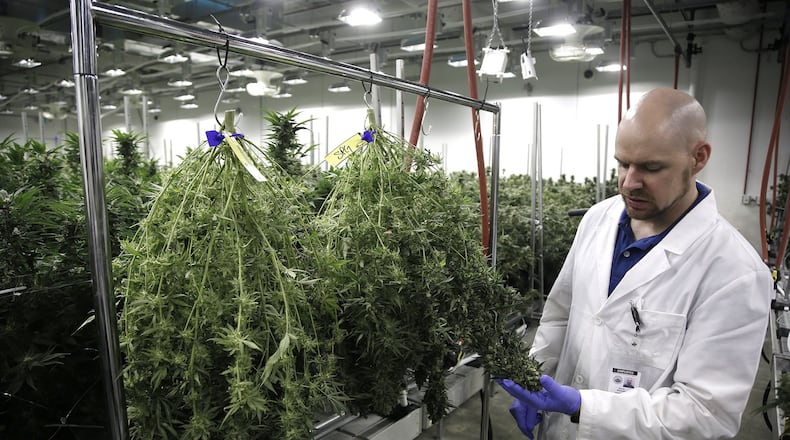RELATED: Area’s first medical pot dispensary opens, more shops coming soon
This time last year, there were only four dispensaries open: two in Wintersville, one in Sandusky and one in the Cleveland area.
Today there are 46 dispensaries operating and 12 more have certificates of operation or provisional licenses and are working to become operational, according to the Ohio Medical Marijuana Control Program. Ali Simon, a spokeswoman for the State of Ohio Board of Pharmacy, said that more than 400 applications were submitted for dispensaries at the beginning of the program.
“The program has come a long way since then,” Rosenberger said.
Patients
As of November 30, the most recent data available, 74,768 Ohioans have registered with the state’s medical marijuana program.
RELATED: County’s first medical pot dispensary opens: ‘I feel so much more in control of my health.’
About 7% of those registered are veterans.
The three most common conditions Ohio patients buy medical marijuana for are cancer, fibromyalgia and post-traumatic stress disorder, according to that same data.
According to reports from licensed dispensaries to the Ohio Automated Rx Reporting System (OARRS), 51,237 unique patients have purchased medical marijuana since the start of the program, .
Larry Pegram is president of Pure Ohio Wellness, a level I cultivator that also operates several dispensaries in the Dayton-area.
Pegram said the average person who uses medical marijuana is 55 years or older.
“A lot of people I talk to are people who don’t want to take opiates anymore, many of them have chronic pain,” Pegram said.
As of Dec. 9, 5,925 pounds of plant material have been sold in the state. In addition to that, 236,008 units of manufactured product, like edibles, patches or oils for vaporization, have been sold.
Smoking the flower is prohibited by the law passed in 2016, but medical cannabis can be vaped and used in edibles and oils by patients for 21 approved conditions.
Ohio has seen $49.4 million in product sales since the start of the medical marijuana program in the state, according to the Medical Marijuana Control Program.
There are 590 doctors in the state who are certified to recommend.
To be able to purchase medical marijuana in Ohio, a patient must have one of the qualifying conditions and then get a recommendation from their doctor.
RELATED: Medical users say Ohio’s pot pricey and inconvenient
Pricing
Medical marijuana has also become more available in 2019 because prices have come down.
When the program first started, an ounce of product cost “well over $400,” Rosenburger said. Nearly a year later, a patient can get an ounce of medical marijuana for about $300.
“We’ve seen prices drop as more cultivators are coming online,” Rosenburger said.
On the first day of the program, patients could only purchase the flower. Patients can now purchase a variety of products.
“We’ve seen the number of purchases catch up to the number of people who are registered,” Rosenburger said.
Stigma
Pure Ohio Wellness has a dispensary at 1875 Needmore Road in Dayton and 1711 W. Main St. in Springfield. Pegram said the company plans to open a dispensary in Logan, Ohio, in the next couple of months.
“Any time you start a program like this, there are going to be issues,” Pegram said.
Pegram said the building on Needmore Road used to be a hookah bar and there were a lot of crime incidents there.
“I think the locals thought we’d be a continuation of that,” Pegram said. “But we’ve actually been almost the opposite. Nationally, I think the stigma around marijuana is dropping away. People are seeing this as an alternative medicine.”
n’s first medical marijuana dispensary opens
Future of the program
While those in the medical marijuana industry say the program has come a long way in the past year, many feel there is still more work to do.
“We need to make it easier for patients to see doctors. It’s so complicated right now,” Pegram said.
The Ohio Medical Marijuana Control Program has proposed some rule changes, including a rule that would bar dispensary ownership from changing until after a shop has been open for 12 months. This proposal has caused some operators to put on hold the opening of new dispensaries.
Simon predicted that patients and caregivers wouldn’t see much change in the program in the next year or so, even with these rule changes.
“I predict that 2020 will look a lot like the last half of 2019,” Simon said.
Many of the proposed rule changes address questions that have popped up in the first year of the medical marijuana program, Simon said.
The pharmacy board is still working to get the remaining 12 dispensaries open in 2020, Simon said.
“I think the state is doing a great job,” Pegram said. “You know what you’re getting here in Ohio and in other states it is not that way.”
By the numbers
What does the typical medical marijuana patient look like?
7% - percent of registered medical marijuana patients who are veterans
16% - percent of patients registers to get medical marijuana for post-traumatic stress disorder
20% - percent of registered patients who are 60 to 69 years old
21% - percent of registered patients 50 to 59 years old
About the Author





